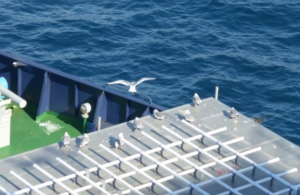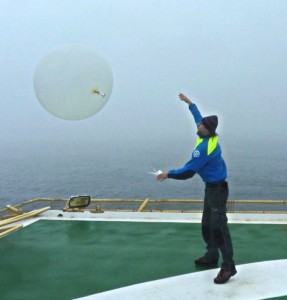22 July 2014, by Matt Shupe [76N, 128E]:
We are operating a collection of NOAA instruments on Oden during ACSE / SWERUS. So perhaps a few words about what these are and why they are here.
- Cloud Radar: My personal favorite, this system transmits microwave pulses that reflect off of cloud particles in the atmosphere. Their returned signal tells us about the cloud mass, the speed of the cloud droplets, and other cloud properties. It operates with a motion compensating platform that does a great job of keeping the radar pointing vertical in the face of ship motions.
- Microwave Radiometer: This system operates at a similar frequency to the cloud radar, but passively measures downwelling microwave radiation from the atmosphere that contains information on the amount of liquid water and water vapor, and some information on the temperature profile.
- Ceilometer: This is a fancy laser that operates in the near-IR (so we can’t see it), telling us about the distance to the cloud base.
- Wind Profiling Radar: Similar concept to the cloud radar, except with a much longer wavelength such that the returned energy reflects from refractive index gradients in the atmosphere. Measurements in multiple directions can be interpreted together to give a horizontal wind profile. Birds have enjoyed perching on the antenna backplane, and we may see them in the data at times.
- Sea Snake: This resembles a hose simply thrown over the side of the ship. It floats along the top of the ocean measuring temperature.

Birds on the radar
The other members of our collaborative “Boundary Layer Meteorology” team make complementary measurements of surface turbulent fluxes, basic meteorological properties, radiation, winds, and a four-times-daily radiosonde program. Michael does three of the daily soundings and the rest of us rotate on the midnight sonde. These weather balloons, launched each day all around the world, are the backbone of our global weather forecast systems. Data is directly uploaded to a global network to feed the best information possible into forecast models. Jointly this collection of ACSE instruments will teach us about how the clouds and atmosphere interact with a changing surface as we move along our course.

